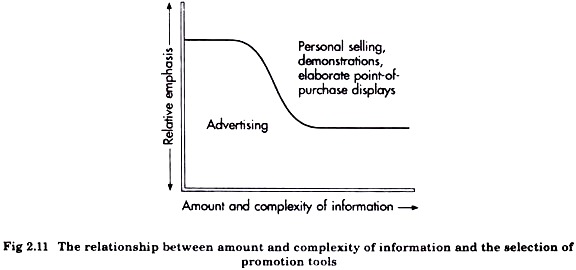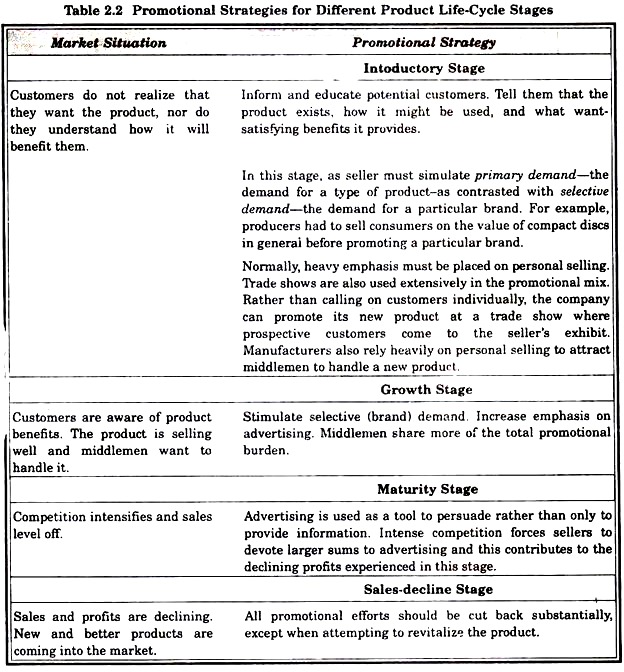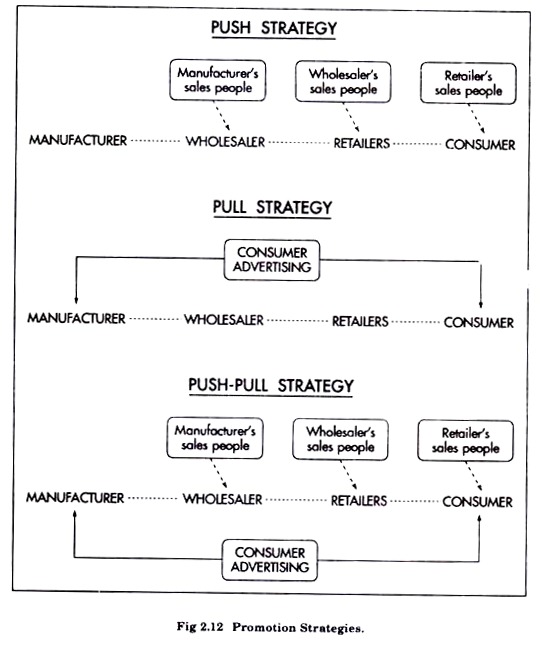This article throws light upon the top four factors influencing promotional mix. The factors are: 1. Product Related Factors 2. Consumer Related Factors 3. Firm Related Factors 4. Situation Related Factors.
Factor # 1. Product Related Factors:
Three product related factors affect the promotion mix as:
(a) Amount and complexity of product information
(b) Product’s stage in the life cycle
(c) Product type and unit price.
(a) Amount and Complexity of Product Information:
To inform and persuade the simple product, means features are easily observed and to some extent products which are familiar to the customers, the emphasis is given on advertising. To demonstrate or for technical product the emphasis is given on personal selling and sales promotion.
Personal contacts also enables consumers to experience the product and to ask questions. Fig. 2.11 develops the relationship between the amount and complexity of information and the selection of promotion tools.
(b) Stage of the Product Life Cycle:
At the different stages of the product life cycle, as the promotional objective is different, the different elements are being selected to suit the needs. The Table 2.2 briefs which promotional mix element is optimally suited for different stages of life cycle.
(c) Product Type and Unit Price:
Heavy emphasis is placed on advertising for relatively inexpensive consumer products items while a high unit price receive more personal selling support because consumers want more detailed and personalized information. Personal selling is more important at all price levels for industrial products but receives greater emphasis at the higher unit price levels.
Factor # 2. Consumer Related Factors:
Two consumer related factors are to be considered:
(a) Size and characteristics of the target market.
(b) Type of buying decision.
(a) Size and Characteristics of the Target Market :
Non personal forms of promotion such as sales promotion, publicity and advertising are favoured as the size of the target market increases homogeneously. If the market is heterogeneous and small, personal selling is best suited. The choice of the promotion mix for products with a relatively small target market depends on whether people in it are relatively similar or not.
(b) Type of Buying Decision:
If the consumers are making the programmed purchases of the firm’s brand, promotion focuses on calling attention to the brand at the point of purchase like point of purchase display etc. If they make programmed purchases of rival brands, promotion might focus on appeals like, if you are tired of brand, try ours.
In the case of non programmed decisions the promotion mix must be highly informative. The effects of competitors programme is also considered.
Factor # 3. Firm Related Factors:
The firm has to consider the following factors:
(a) Marketing channel and promotion strategy
(b) Branding strategy
(c) Pricing strategy
(d) Company personnel
(e) Budget availability of funds.
(a) Marketing Channel and Promotion Strategy:
The marketer has to choose any of the following three strategy relating to distribution channel. They are (Fig. 2.12)
(i) Push strategy
(ii) Pull strategy
(iii) Gravity strategy
(i) Push Strategy:
It involves pushing or urging members of the market channel to sell a product or give it adequate display. The primary promotional tool used is personal selling directed towards middle men.
A push strategy typically involves heavy reliance by the manufacturer on the company’s sales force, personal selling and various types of sales promotion directed to company sales people and to middle men and their sales forces. Examples include sales contests for company sales people, dealer contests and manufacturer—supplied incentives for sales person.
So, the firm that want to use push strategy must develop a marketing channel that includes wholesalers that have their own sales force and a network of retailers who will promote the product aggressively.
(ii) Pull Strategy:
In this strategy the manufacturer tries to stimulate ultimate consumer or industrial user himself instead of middle men. Thus, here the emphasis is on that consumers will ask the product from middle men by name. Here the consumer ‘pull’ the product through marketing channel.
Thus, pull strategy typically involves heavy spending by the manufacturer on advertising and various types of sales promotion that are directed to ultimate consumers or industrial users. Most concern favour the combination of push and pull strategy by using the balance advertising, personal selling and sales promotion directed toward middlemen and consumers.
(iii) Gravity Strategy:
It involves concentrating on producing a superior product and depending only on word of mouth to sell it. Satisfied customers—whether a wholesaler, retailer, customer or industrial buyer are expected to create demand for the product.
(b) Branding Strategy:
Through brands an image is being created and that image is to be created at each level of the marketing channel. For example, family branding requires less promotion effort to introduce the new product.
A very small amount of advertising to create customer awareness will be needed because the new product capitalizes on the family brand’s image. Consumers may try it because of their satisfaction with other products with the family brand name.
(c) Pricing Strategy:
Promotion mix decisions often are affected by pricing strategy. In the case of high priced products, personal selling play a major role because buyers typically perceive considerable risk in buying such products. In the case of convenience goods advertising is emphasized.
(d) Availability of Funds:
This is one of the major factor as without funds nothing can happen. Each element of the promotion mix has a cost. For each and every activity budget is being prepared. Firm choose among promotion elements on the basis of the relative cost of reaching an intended receiver.
As we know that personal selling is very expensive per person reached than advertising. Sales promotion may be expensive or relatively low cost depending upon the type used. Public relations generally is considered a necessary part of doing business and its budget often is considered separately from a firm’s promotional budget-
Most of the marketers try to select that mix that optimize their return. The promotion mix that is settled is a trade-off between the funds available, number of people in the target market, quality of the communication needed and the relative cost of the different promotion elements.
(e) Company Personnel:
The factor is related to expertise and peculiarities of a firm’s personnel. Some firms lack experience with certain promotion elements and do not use them.
Factor # 4. Situation Related Factors:
Include the following factors:
(a) Visibility of the firm
(b) Competitor’s action.
(a) Visibility of the Firm:
Some Firms are more visible to the public because of their products and relative position in the industry. More people are concerned are concerned about the theirs of highly visible firms. Thus, these firms spend relatively more on public relation.
This is also true for firms that have large market share. Firms whose actions are essential to or are potentially harmful to the public welfare such as chemical, transportation, pharmaceutical, petroleum and steel companies and public utilities, also spend heavily on public relations.
(b) Competitor’s Actions:
Competitor’s promotional activities also affect the mix. Firms often have to mat counter the promotional activities of the rivals to maintain or increase their market share.


